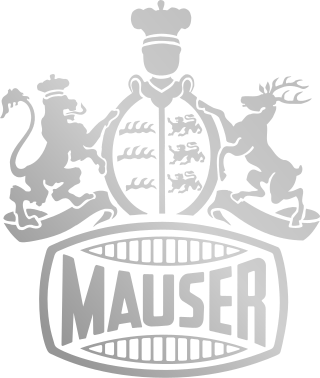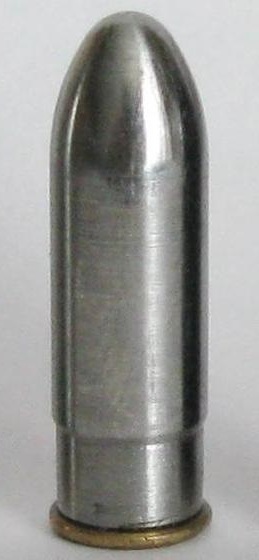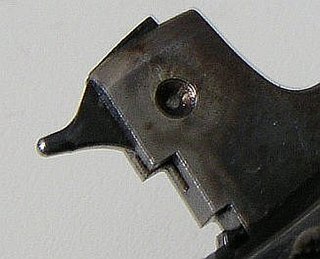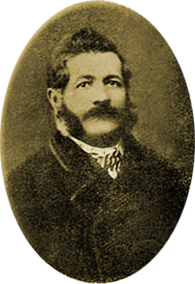
A needle gun (or needle rifle for varieties with rifling) is a firearm that has a needle-like firing pin, which can pass through the paper cartridge case to strike a percussion cap at the bullet base.

A needle gun (or needle rifle for varieties with rifling) is a firearm that has a needle-like firing pin, which can pass through the paper cartridge case to strike a percussion cap at the bullet base.

The first experimental needle gun was designed by Jean Samuel Pauly, a Swiss gunsmith.
In 1808, in association with French gunsmith François Prélat in Paris, France. Pauly created the first fully self-contained cartridges: [1] the cartridges incorporated a copper base with integrated mercury fulminate primer powder (the major innovation of Pauly), a round bullet and either brass or paper casing. [2] [3] The cartridge was loaded through the breech and fired with a needle. The needle-activated central-fire breech-loading gun became a major feature of firearms thereafter. [4] The corresponding firearm was also developed by Pauly. [1] Pauly made an improved version which was protected by a patent on 29 September 1812. [1] The cartridge was further improved by the French gunsmith Casimir Lefaucheux in 1836.
In 1809, Pauly employed the German Johann Nicolaus von Dreyse, who later invented the famous Dreyse rifle.

The first mass-produced needle gun was invented by the German gunsmith Johann Nicolaus von Dreyse, who, beginning in 1824, had conducted multiple experiments, and in 1836 produced the first viable breech loading gun model using a complete cartridge.
The early Dreyse needle guns were smooth-bore. Later Dreyse guns adopted by the Prussian army were rifles using self-contained combustible cartridges holding oblong lead balls held in a papier-mâché "sabot".
From 1848 onwards the new weapon was gradually introduced into Prussian service. Between 1849-1867, The British military inspector had trial an early bolt action variants. [5] The Dreyse rifle became widely used during the Austro-Prussian War of 1866 when it played a decisive role at the Battle of Königgrätz.
This Model 1861 rifle was an improvement of the Dreyse rifle by Johannes Doersch and Cramer von Baumgarten. They shortened the needle mechanism and moved the handle to the rear of the bolt. The rifle was officially adopted in the Principality of Schaumburg-Lippe. More than one thousand rifles were produced until the principality was forced to join the German Empire in 1871.
In 1865, Johannes Friedrich Christian Carl (also known as Carlé or Karl), a ship- and insurance broker of Hamburg, patented a needle gun which was an improvement on the Dreyse gun. Sohs (Zons), a Hamburg citizen, participated in the design and development of it.
The Carl system was officially adopted by the Russian Empire in 1867. Only 215,500 Carl rifles were manufactured in Russia, because a short time later, needle rifles were replaced by rifles with metal cartridges, such as the Berdan rifle.


The Chassepot was named after its inventor, Antoine Alphonse Chassepot (1833–1905), who, from 1857 onwards, had constructed various experimental forms of breechloader, and the rifle became the French service weapon in 1866. In the following year it made its first appearance on the battlefield at Mentana on 3 November 1867, where it inflicted severe losses upon Giuseppe Garibaldi's troops. It was reported at the French Parliament that "Les Chassepots ont fait merveille !", or loosely translated: "The Chassepots have done wonderfully!" The heavy cylindrical lead bullets fired at high velocity by the Chassepot rifle inflicted wounds that were even worse than those of the earlier Minié rifle.
In the Franco-Prussian War (1870–71) it proved greatly superior to the German Dreyse needle gun, outranging it by 2 to 1.
The Chassepot used a paper cartridge, that many refer to as being 'combustible', whereas in reality it was quite the opposite. It held an 11-millimetre (0.43 in) round-headed cylindro-conoidal lead bullet that was wax paper patched. An inverted standard percussion cap was at the rear of the paper cartridge and hidden inside. It was fired by the Chassepot's needle (a sharply pointed firing pin) upon pressing the trigger.
The Carcano Fucile di Fanteria Modello 1860/67 needle gun was developed by Salvatore Carcano, an Italian technician. This rifle was operated by pulling a cocking knob on the back of the action, retracting the needle and allowing the bolt handle to be lifted. It was adopted in 1867 in Italy.
The Carcano Modello 1868 needle fire rifle had very few differences from the 1860/1867 model.

A rifle is a long-barreled firearm designed for accurate shooting and higher stopping power, with a barrel that has a helical pattern of grooves (rifling) cut into the bore wall. In keeping with their focus on accuracy, rifles are typically designed to be held with both hands and braced firmly against the shooter's shoulder via a buttstock for stability during shooting. Rifles are used extensively in warfare, law enforcement, hunting and target shooting sports.

In firearm designs, the term single-shot refers to guns that can hold only a single round of ammunition inside and thus must be reloaded manually after every shot. Compared to multi-shot repeating firearms ("repeaters"), single-shot designs have no moving parts other than the trigger, hammer/firing pin or frizzen, and therefore do not need a sizable receiver behind the barrel to accommodate a moving action, making them far less complex and more robust than revolvers or magazine/belt-fed firearms, but also with much slower rates of fire.

The percussion cap, percussion primer, or caplock, introduced in the early 1820s, is a type of single-use percussion ignition device for muzzle loader firearm locks enabling them to fire reliably in any weather condition. Its invention gave rise to the caplock mechanism or percussion lock system which used percussion caps struck by the hammer to set off the gunpowder charge in rifles and cap and ball firearms. Any firearm using a caplock mechanism is a percussion gun. Any long gun with a cap-lock mechanism and rifled barrel is a percussion rifle. Cap and ball describes cap-lock firearms discharging a single bore-diameter spherical bullet with each shot.

Bolt-action is a type of manual firearm action that is operated by directly manipulating the bolt via a bolt handle, which is most commonly placed on the right-hand side of the firearm.

In firearms terminology, an action is the functional mechanism of a breech-loading firearm that handles the ammunition cartridges, or the method by which that mechanism works. Actions are technically not present on muzzleloaders, as all those are single-shot firearms with a closed off breech with the powder and projectile manually loaded from the muzzle. Instead, the muzzleloader ignition mechanism is referred to as the lock.

The Chassepot, officially known as Fusil modèle 1866, was a bolt-action military breechloading rifle. It is famous for having been the arm of the French forces in the Franco-Prussian War of 1870–1871. It replaced an assortment of Minié muzzleloading rifles, many of which were converted in 1864 to breech loading. An improvement to existing military rifles in 1866, the Chassepot marked the commencement of the era of modern bolt action, breech-loading military rifles. The Gras rifle was an adaption of the Chassepot designed to fire metallic cartridges introduced in 1874.

Mauser, originally the Königlich Württembergische Gewehrfabrik, was a German arms manufacturer. Their line of bolt-action rifles and semi-automatic pistols was produced beginning in the 1870s for the German armed forces. In the late 19th and early 20th centuries, Mauser designs were also exported and licensed to many countries, which adopted them as military and civilian sporting firearms. The Gewehr 98 in particular was widely adopted and copied, and it is the foundation of many of today's sporting bolt-action rifles.

A breechloader is a firearm in which the user loads the ammunition from the breech end of the barrel, as opposed to a muzzleloader, in which the user loads the ammunition from the (muzzle) end of the barrel.
A repeating rifle is a single-barreled rifle capable of repeated discharges between each ammunition reload. This is typically achieved by having multiple cartridges stored in a magazine and then fed individually into the chamber by a reciprocating bolt, via either a manual or automatic action mechanism, while the act of chambering the round typically also recocks the hammer/striker for the following shot. In common usage, the term "repeating rifle" most often refers specifically to manual repeating rifles, as opposed to self-loading rifles, which use the recoil, gas, or blowback of the previous shot to cycle the action and load the next round, even though all self-loading firearms are technically a subcategory of repeating firearms.

Caseless ammunition (CL), or caseless cartridge, is a configuration of weapon-cartridge that eliminates the cartridge case that typically holds the primer, propellant and projectile together as a unit. Instead, the propellant and primer are fitted to the projectile in another way so that a cartridge case is not needed, for example inside or outside the projectile depending on configuration.

A mitrailleuse is a type of volley gun with barrels of rifle calibre that can fire either all rounds at once or in rapid succession. The earliest true mitrailleuse was invented in 1851 by Belgian Army captain Fafschamps, ten years before the advent of the Gatling gun. It was followed by the Belgian Montigny mitrailleuse in 1863. Then the French 25 barrel "Canon à Balles", better known as the Reffye mitrailleuse, was adopted in great secrecy in 1866. It became the first rapid-firing weapon deployed as standard equipment by any army in a major conflict when it was used during the Franco-Prussian War of 1870–71.

A firing pin or striker is a part of the firing mechanism of a firearm that impacts the primer in the base of a cartridge and causes it to fire. In firearms terminology, a striker is a particular type of firing pin where a compressed spring acts directly on the firing pin to provide the impact force rather than it being struck by a hammer.

The Dreyse needle-gun was a 19th-century military breech-loading rifle, as well as the first breech-loading rifle to use a bolt action to open and close the chamber. It was used as the main infantry weapon of the Prussians in the Wars of German Unification. It was invented in 1836 by the German gunsmith Johann Nikolaus von Dreyse (1787–1867), who had been conducting numerous design experiments since 1824.

Johann Nicolaus von Dreyse was a German firearms inventor and manufacturer. He is most famous for submitting the Dreyse needle gun in 1836 to the Prussian army, which was adopted for service in December 1840 as the Leichte Perkussions-Gewehr M 1841 – a name deliberately chosen to mislead about the rifle's mechanism – later renamed Zündnadelgewehr M 1841 in 1855.

Rotating bolt is a method of locking the breech of a firearm closed for firing. Johann Nicolaus von Dreyse developed the first rotating bolt firearm, the "Dreyse needle gun", in 1836. The Dreyse locked using the bolt handle rather than lugs on the bolt head like the Mauser M 98 or M16. The first rotating bolt rifle with two lugs on the bolt head was the Lebel Model 1886 rifle. The concept has been implemented on most firearms chambered for high-powered cartridges since the 20th century.

A service rifle is a rifle a military issues to its regular infantry. In modern militaries, this is generally a versatile, rugged, and reliable assault rifle or battle rifle, suitable for use in nearly all environments and is effective in most combat situations. Almost all modern militaries are issued service pistols as sidearms to accompany their service rifles. The term can also be used to describe weapons issued by non-military forces, such as law enforcement or paramilitaries.
The Minié rifle was an important infantry rifle of the mid-19th century. A version was adopted in 1849 following the invention of the Minié ball in 1847 by the French Army captain Claude-Étienne Minié of the Chasseurs d'Orléans and Henri-Gustave Delvigne. The bullet was designed to allow rapid muzzle loading of rifles and was an innovation that brought about the widespread use of the rifle as the main battlefield weapon for individual soldiers. The French adopted it following difficulties encountered by the French army in North Africa, where their muskets were overtaken in range by long-barreled weapons which were handcrafted by their Algerian opponents. The Minié rifle belonged to the category of rifled muskets.
The evolution of German military rifles is a history of common and diverse paths followed by the separate German states, until the mid-19th century when Prussia emerged as the dominant state within Germany and the nation was unified. This article discusses rifled shoulder arms developed in or for the military of the states that later became Germany; it excludes firearms of the Austrian Empire, except where they were used substantially by German troops.
The Podewils rifle-musket was a 13.9mm calibre rifle used in the Bavarian army since 1858. It was the most common infantry weapon of the Bavarian army in the Austro-Prussian war of 1866 and the Franco-Prussian war of 1870/71. Theodor Fontane called it an "excellent" weapon of the Austro-Prussian war due to its long range. Originally a muzzleloader, it was converted to breechloading in 1867, the so-called Lindner conversion. In 1869 the Bavarian army started to replace it with the Werder breechloader, but due to budgetary constrains by 1870 most Bavarian troops still used the Podewils while only four infantry battalions had received the Werder. Even the Lindner conversion was inferior to both the Prussian Dreyse needle gun and the French Chassepot.

Salvatore Carcano was an Italian inventor renowned for designing the Carcano bolt-action rifle, adopted by the Italian Regio Esercito throughout World War II.
{{cite web}}: CS1 maint: archived copy as title (link)